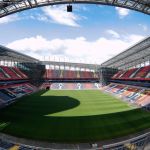
House of Sports: CSKA Moscow
The Russian never do something small and cheap
January 29th, 2017
To frame sports in a proper way has become essential in these days: so many sports franchises in the world are building owned stadiums, an unavoidable spring of incomes with today’s economic laws, a worldwide symbolic tool and, sometimes, explosion of fantasy and architectural perfection. Today no sports structure at the highest level is just a sports structure: it has to be, in order to be on the same page with current times, a 360 degrees structure, not only available for one game per week. We’re going to see stadiums, arenas, buildings and structures that have seen the most important pages in the history of sports, for the most various reasons: from the most famous competitions to the most incredible events, also with an eye on future’s sports places.

CSKA Arena is this year’s CSKA Moscow’s new stadium. In the first place, the stadium should’ve see life in 2006, after the Uefa Cup win - first trophy ever by a Russian team - which persuaded the owner Yevgeniy Giner to commission the project to a construction company called Mosproekt-4. The project and the construction, set in the eastern-center of Moscow, had to overcome many bureaucratic and financial obstacles, staying stopped for almost two years between 2009 and 2011, until the inauguration happened on September the 10th, 2016, with a 3-0 win against Terek Grozny.
The stadium has 30 thousands seats, an average data for the league and a wise choice, based on a very specific market strategy, used also by Juventus: limited the seats in order to get the sold out stadium most of the times, giving an amazing atmosphere every time the team plays. During last season, the capital’s team, even if it was favorite and winning at the end of the season, had just the 10th average of attendance at games. A result that doesn't fit into team’s merit, also involved in European tournaments. Fortunately, they had an improvement: in the first part of this new season, the average attendance has increased until 12 thousand, 5th in the league.

The cost of the operation was around 350 million, almost three times the forecasted price of 100 million. A very expensive market operation, but with an excellent outcome. The skyscraper in the northwest corner is a clear reference to the Uefa Cup and it’s 142 meters tall, so it can be seen from every part of the city. This tower is the highest part of a stadium ever built, and it hosts hotels, offices, restaurants and of course the unavoidable team shop with hundreds of gadgets. Almost 3000 people benefit of this project, employed after the stadium’s construction. The area where the stadium is built is a big and residential neighborhood, with 4 metro stations and 1300 spots for fans’ cars. It also has tons of hotels for visiting supporters.

From this point of view, Russia is making big steps ahead, looking forward to 2018 World Cup. CSKA Arena isn't among other stadiums selected for the tournament because of the lack of seats, too few to be involved. Among the stadiums, there will be the Otkrytie Arena, the Spartak Moscow’s jewel which was inaugurated two years ago and will host the next Confederations Cup. Also looking forward to 2018, it has been announced the renovation of the Luzhniki Stadium, which will have 81.000 seats, instead of 89.000. This stadium has already hosted a very important European competition, 2008 Champions League final between Chelsea and Manchester United.















